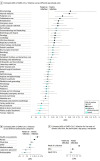Seroprevalence of and Risk Factors Associated With SARS-CoV-2 Infection in Health Care Workers During the Early COVID-19 Pandemic in Italy
- PMID: 34228126
- PMCID: PMC8261609
- DOI: 10.1001/jamanetworkopen.2021.15699
Seroprevalence of and Risk Factors Associated With SARS-CoV-2 Infection in Health Care Workers During the Early COVID-19 Pandemic in Italy
Abstract
Importance: Identifying health care settings and professionals at increased risk of SARS-CoV-2 infection is crucial to defining appropriate strategies, resource allocation, and protocols to protect health care workers (HCWs) and patients. Moreover, such information is crucial to decrease the risk that HCWs and health care facilities become amplifiers for SARS-CoV-2 transmission in the community.
Objective: To assess the association of different health care professional categories and operational units, including in-hospital wards, outpatient facilities, and territorial care departments, with seroprevalence and odds of SARS-CoV-2 infection.
Design, setting, and participants: This cross-sectional study was conducted using IgG serological tests collected from April 1 through May 26, 2020, in the Lombardy region in Italy. Voluntary serological screening was offered to all clinical and nonclinical staff providing any health care services or support to health care services in the region. Data were analyzed from June 2020 through April 2021.
Exposures: Employment in the health care sector.
Main outcomes and measures: Seroprevalence of positive IgG antibody tests for SARS-CoV-2 was collected, and odds ratios of experiencing infection were calculated.
Results: A total of 140 782 professionals employed in the health sector were invited to participate in IgG serological screening, among whom 82 961 individuals (59.0% response rate) were tested for SARS-CoV-2 antibodies, with median (interquartile range [IQR]; range) age, 50 (40-56; 19-83) years and 59 839 (72.1%) women. Among these individuals, 10 115 HCWs (12.2%; 95% CI, 12.0%-12.4%) had positive results (median [IQR; range] age, 50 [39-55; 20-80] years; 7298 [72.2%] women). Statistically significantly higher odds of infection were found among health assistants (adjusted odds ratio [aOR], 1.48; 95% CI, 1.33-1.65) and nurses (aOR, 1.28; 95% CI, 1.17-1.41) compared with administrative staff and among workers employed in internal medicine (aOR, 2.24; 95% CI, 1.87-2.68), palliative care (aOR, 1.84; 95% CI, 1.38-2.44), rehabilitation (aOR, 1.59; 95% CI, 1.33-1.91), and emergency departments (aOR, 1.56; 95% CI, 1.29-1.89) compared with those working as telephone operators. Statistically significantly lower odds of infection were found among individuals working in forensic medicine (aOR, 0.40; 95% CI, 0.19-0.88), histology and anatomical pathology (aOR, 0.71; 95% CI, 0.52-0.97), and medical device sterilization (aOR, 0.54; 95% CI, 0.35-0.84) compared with those working as telephone operators. The odds of infection for physicians and laboratory personnel were not statistically significantly different from those found among administrative staff. The odds of infection for workers employed in intensive care units and infectious disease wards were not statistically significantly different from those of telephone operators.
Conclusions and relevance: These findings suggest that professionals partially accustomed to managing infectious diseases had higher odds of SARS-CoV-2 infection. The findings further suggest that adequate organization of clinical wards and personnel, appropriate personal protective equipment supply, and training of all workers directly and repeatedly exposed to patients with clinical or subclinical COVID-19 should be prioritized to decrease the risk of infection in health care settings.
Conflict of interest statement
Figures



References
-
- Nguyen LH, Drew DA, Graham MS, et al. ; Coronavirus Pandemic Epidemiology Consortium . Risk of COVID-19 among front-line health-care workers and the general community: a prospective cohort study. Lancet Public Health. 2020;5(9):e475-e483. Published online July 31, 2020. doi: 10.1016/S2468-2667(20)30164-X - DOI - PMC - PubMed
Publication types
MeSH terms
Substances
LinkOut - more resources
Full Text Sources
Medical
Miscellaneous

